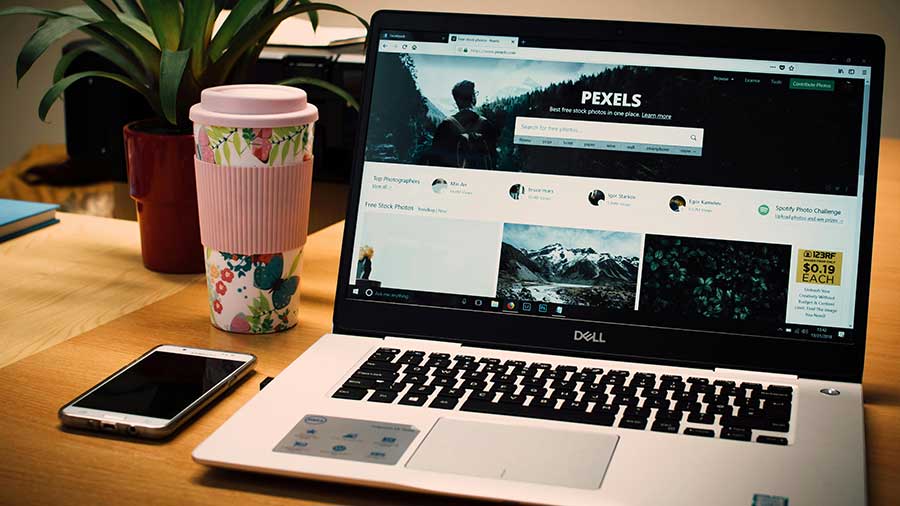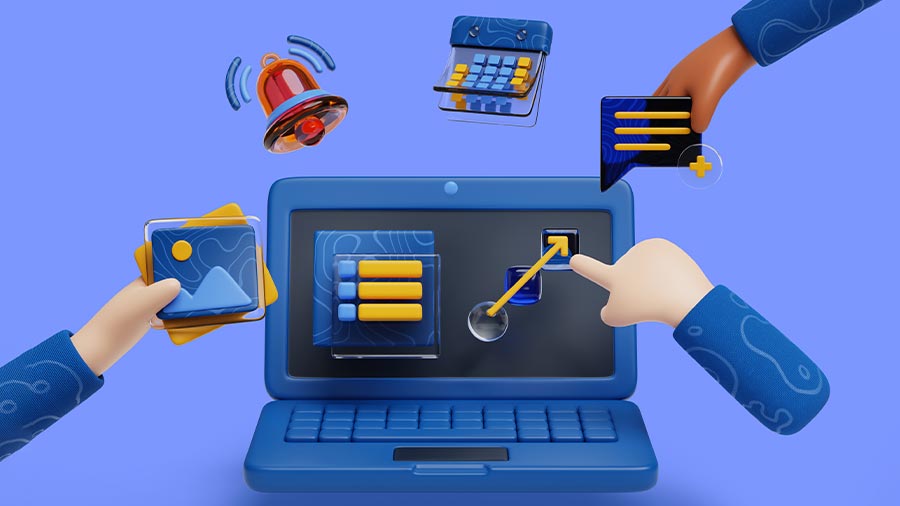As more business interactions shift to digital platforms, organizations risk losing the personal website touch that builds trust and long-term relationships. Today’s B2B buyers expect tailored experiences—whether researching solutions, comparing vendors, or engaging with content. Website personalization, delivering tailored content and experiences to individual visitors based on their behaviors and preferences, enables companies to meet these expectations by providing relevant products, services, and insights aligned with each customer’s needs. By customizing websites and the browsing experience, businesses can improve engagement, nurture leads, and drive higher conversion rates throughout the sales cycle. This article offers a comprehensive guide on the types of website personalization, its application across the customer journey, impact measurement, real-world examples, emerging trends, and practical tips for B2B success.
Why Does B2B Website Personalization Matter?
In B2B, buyers expect tailored experiences that speak directly to their roles, industries, and business challenges. Generic websites and one-size-fits-all messaging no longer resonate with today’s decision-makers, who research solutions extensively before engaging with sales. Personalization addresses this by delivering content, product recommendations, and messaging relevant to each visitor’s needs, increasing engagement and building trust.
Highly targeted experiences also accelerate the sales pipeline. By presenting the right information at the right stage of the buyer journey, personalization nurtures lead more effectively, reducing friction and shortening the path from awareness to purchase. Additionally, personalization enables account-based marketing strategies, allowing teams to engage multiple stakeholders within an organization with messaging tailored to their roles and priorities. In addition, a website personalization strategy helps businesses tailor content and offers to individual users, enhancing engagement and conversions. For example, offering personal website templates as part of a self-service toolkit or content hub can empower clients to create branded experiences that align with their objectives, further strengthening the relationship. The benefits of website personalization include improved user experience, higher customer satisfaction, and increased sales. Altogether, B2B website personalization drives measurable revenue. By implementing an effective website personalization strategy, companies can unlock the full benefits of website personalization and build stronger customer relationships.
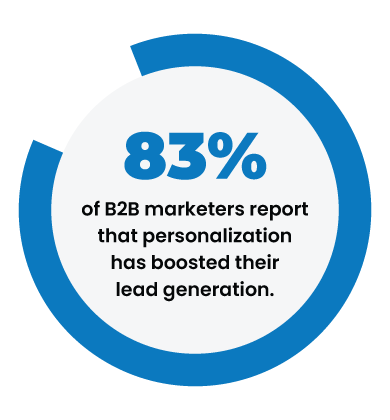 Personalization vs. Customization: Key Distinctions
Personalization vs. Customization: Key Distinctions
In B2B marketing, the terms “personalization” and “customization” are often used interchangeably, but they represent two very different approaches to engaging prospects and accounts. Understanding the distinction is critical for designing effective digital experiences that drive pipeline and revenue.
Personalization leverages data and technology to deliver tailored experiences for individual decision-makers or target accounts. By analyzing firmographics, browsing behavior, engagement history, and buyer intent, B2B companies can present relevant content, solutions, or recommendations to each visitor. Examples include account-specific landing pages, dynamic product recommendations based on previous interactions, or personalized email campaigns aligned with a prospect’s role or industry. Personalization is proactive; your systems anticipate what each user needs, guiding them through the buyer journey efficiently.
Customization, in contrast, allows customers to define their own experience by selecting from a set of predefined options. In a B2B context, this could mean configuring a software solution package, choosing modules or features in a SaaS website personalization platform, or selecting service tiers. Unlike website content personalization software, which leverages data and automation to tailor experiences dynamically, customization puts the user in control of shaping their experience based on their preferences.
The key distinction: personalization is data- and technology-driven, delivering targeted experiences based on insights, while customization is user-driven, allowing choices within set parameters. Personalization often requires sophisticated platforms and analytics but drives higher engagement, faster pipeline movement, and more relevant interactions across complex B2B buying groups. Customization can complement personalization but is less proactive in guiding prospects toward desired outcomes.
Building Blocks of B2B Website Personalization
A successful personalized marketing strategy depends on a website personalization engine with four essential components, enabling brands to gather, analyze, and leverage data to deliver relevant, highly targeted experiences for every customer.
A Unified Dataset:
To effectively personalize the customer journey, you need a cohesive dataset. This means bringing together data from every source—including website behavior, CRM systems, email interactions, and more. When you use a single, holistic website personalization platform instead of disconnected tools, all your data flows seamlessly. This unified view allows you to capture important actions and behaviors at every touchpoint, which in turn fuels rich, contextual experiences for each visitor.
An Open Architecture:
A great website personalization engine should integrate smoothly with your existing marketing technology, regardless of the vendor. This flexibility is key. It allows your brand to deploy complex personalization strategies faster, reduces engineering work, and accelerates the delivery of value. An open system ensures that you can adapt to new tools and technologies without disrupting the customer experience, helping you create standout, adaptive experiences that contribute to being recognized among the best personal websites.
Decision Logic:
Automation is critical for analyzing data and delivering personalized experiences at scale. Trying to manually manage a growing number of segments, variations, and experiments is inefficient and quickly becomes unmanageable. Decision logic powered by machine learning is a core capability of advanced website personalization tools. It automatically assesses customer behaviors, optimizes experiences, and delivers the most relevant interactions to each person.
Real-time Activation:
Personalization is most effective when insights are applied instantly. Real-time activation turns data-driven decisions into immediate, relevant experiences across all digital channels—from websites and emails to mobile apps. This ensures every interaction resonates with the individual, boosting engagement and driving meaningful customer outcomes without any delays. Delivering such seamless and responsive experiences is what distinguishes the best personal websites from the rest.
Types of B2B Website Personalization
Website content personalization allows brands to deliver tailored experiences that engage visitors and drive conversions. There are four primary ways to personalize your website:
Dynamic Content
Dynamic content adapts in real time to each visitor, displaying relevant products, offers, or messages based on browsing behavior, demographics, or interests. For example, a customer visiting a sports equipment site during winter might see recommendations for snow boots, while returning visitors could be greeted with banners highlighting their favorite brand’s latest running shoes. Dynamic content enhances relevance, increases engagement, and delivers personalized website content offers such as smart countdowns, special promotions, or location-based suggestions.
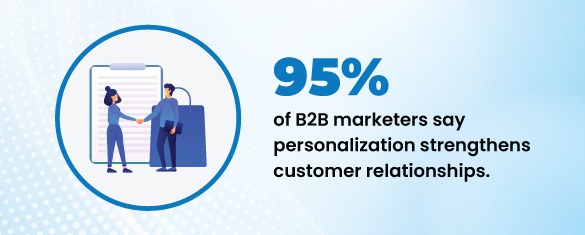
AI-driven product recommendations are essential for modern personalization. By analyzing browsing history, purchase behavior, and preferences, brands can suggest complementary products or items “people like you buy.” For instance, someone viewing sneakers may see related socks, laces, or similar styles. Personalized website content recommendations boost conversions, encourage discovery of new products, and create a more satisfying shopping experience.
Overlays
Overlays, or popovers, act as virtual sales assistants, appearing based on user behavior and preferences. First-time visitors might receive a welcome discount, while returning users could see reminders about items left in their cart or offers on products previously viewed. Overlays help capture leads, recover abandoned carts, increase order value, and gather valuable customer feedback through targeted surveys.
Behavioral Personalization
Behavioral personalization sites tailor the website experience based on real-time user actions and interactions. By tracking clicks, scrolls, time spent on pages, and navigation patterns, brands can dynamically adjust content, offers, and recommendations to match individual behavior. For example, a visitor frequently exploring running shoes might see a homepage featuring top-selling sneakers, relevant blog content, or limited-time offers on related gear. This approach helps guide visitors through the conversion funnel, increases engagement, and ensures that the website feels responsive and intuitive to each user’s unique journey.
Personalization Across the Customer Journey
Personalization is a strategic imperative, not just a marketing tactic. Tailoring the experience for potential and existing business clients at every stage of their journey transforms standard transactions into valuable partnerships, boosting both retention and revenue. Leveraging tools such as web page personalization and site personalization helps you create a seamless, tailored experience that resonates with each visitor’s unique needs.
The Awareness Stage
Making a strong first impression is crucial in B2B. Rather than using generic ads, leverage firmographic and intent data to deliver content that addresses a potential client’s specific business challenges. For example, a company researching cybersecurity solutions might receive a whitepaper on “Securing Cloud Infrastructure for Enterprise” instead of a general product pitch. Using web page personalization techniques ensures the right content appears at the right time. Targeted content marketing and account-based marketing ensure your brand’s relevance from the very first customer touchpoint with a qualified lead.
The Consideration Stage
Once a prospect is evaluating solutions, personalization can be your competitive advantage. A potential client viewing a SaaS platform’s pricing page might receive a personalized case study showing how a similar company achieved a specific ROI. An abandoned demo request can be followed up with a tailored email that highlights key features relevant to their industry. This stage is about using behavioral insights to provide the exact information a prospect needs to move forward, simplifying their complex decision-making process. Website personalization solution briefs and customized email campaigns are essential at this point.
The Decision Stage
In B2B, the sales process itself should be a smooth, personalized experience. A key step is to offer a custom proposal or a tailored contract that directly addresses the client’s unique needs and budget. After a contract is signed, a personalized welcome kit or a thank-you message from the account manager can confirm their decision and build a strong foundation for the relationship. These details show you understand and value their business. Offering personal website templates as part of onboarding or sharing tools for customizing websites helps clients extend personalization within their own teams, further enriching their experience.
The Post-Sale and Advocacy Stage
The B2B journey extends well beyond the initial sale. Personalization is key to turning clients into long-term advocates. Send follow-up communications with resources like training videos or best practices guides based on their product usage. Offering exclusive early access to new features or tailored webinars can also reinforce their value. For instance, a client using your project management software might receive an invitation to a private session on advanced integrations relevant to their team size. This type of proactive, personalized engagement demonstrates a commitment to their success, securing their loyalty and encouraging referrals.
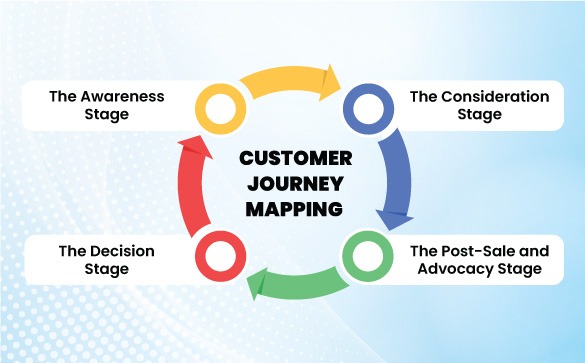
How Do You Create a Website That Adapts to Every Visitor?
Personalizing your website for B2B customers goes beyond simply having the right website personalization tools. True success comes from addressing the key factors that drive meaningful personalization and deliver tangible results for your business.
Segment Your Audience and Create Personas
Start by dividing your B2B audience into meaningful segments. Go beyond basic demographics and use firmographics like industry, company size, and revenue, as well as roles, responsibilities, and key pain points. Pairing these segments with detailed buyer personas helps you understand the unique challenges and interests of each group. This approach ensures your messaging is highly relevant, increasing engagement and the likelihood of conversions for the different decision-makers visiting your personalization site.
Leverage Location and Device Data
Leverage location data to tailor content and offers to specific regions or markets. For example, you can promote region-specific events or highlight case studies from local companies. Also, optimize your site for device type. Mobile users, who are often on the go, need quick-loading, streamlined layouts, while desktop users might benefit from richer, more detailed visuals like interactive dashboards or in-depth product tours. Optimizing for both location and device enhances the user experience and drives more meaningful interactions.
Personalize Key Visuals and Messaging
Your website’s headlines, calls to action (CTAs), and hero images are critical for making a strong first impression. Tailor these elements to different industries, roles, or stages in the buyer’s journey. For example, a visitor from the finance sector could see a headline focused on security and compliance, while a visitor from the tech industry could see content related to scalability and integration. A well-configured website personalization engine applies these changes automatically, ensuring that each visitor sees content aligned with their context, increasing engagement and accelerating conversions.
Customize Content and Navigation
Curate personalized content, such as blog posts, articles, or case studies, based on a visitor’s industry, company size, or past interactions. This shows that you understand their specific needs and builds trust over time. Similarly, personalize navigation menus to surface the most relevant products, solutions, or resources. By making it easier for visitors to find what they need, you encourage deeper exploration and interaction with your site, keeping them engaged and moving them along the sales funnel.
Apply Social Proof and Product Personalization
Showcase industry-specific testimonials, customer logos, and success stories that resonate with each visitor. Highlighting how similar companies have benefited from your solutions builds trust and credibility. Pair this with personalized product or feature recommendations based on a visitor’s role, preferences, or past interactions. Tailored content not only increases satisfaction but also reinforces the perception that your website understands and caters to individual needs, fostering stronger engagement and long-term partnerships.
Cases and Industry Examples: Website Personalization
B2B leaders showcase how effective personalization transforms website experiences. By tailoring content to visitor roles, industries, and behavior, they deliver relevant, targeted interactions that engage users and drive meaningful conversions. Here are website personalization examples of how personalization is being applied across B2B websites:
Salesforce
Salesforce uses personalization to guide users through its complex ecosystem of products and services. When a visitor returns to the site, Salesforce dynamically displays content tailored to their industry, role, and prior interactions. For example, a marketing executive may be shown customer success stories, while an IT lead sees product demos focused on data security solutions. This approach ensures each visitor finds content that’s relevant to their unique needs.
HubSpot
HubSpot personalizes its website experience by serving different content based on where prospects are in the buying cycle. A first-time visitor might see educational blog posts and introductory guides, while a returning customer who’s further along in the process is presented with case studies and product comparisons. This targeted approach helps nurture leads and move them closer to conversion without overwhelming them, using a robust website personalization solution.
IBM
IBM leverages account-based personalization for large enterprise clients. By integrating CRM and intent data, IBM customizes website content to specific accounts and industries. For example, a company in the healthcare sector might see tailored solutions focused on patient data management, while a financial firm sees content about risk analytics. These targeted experiences reinforce IBM’s expertise and relevance in highly regulated industries.
LinkedIn’s B2B personalization extends beyond its platform into its website experience. By analyzing user profiles, job titles, and industry segments, LinkedIn recommends webinars, eBooks, and tools like website personalization solutions that align with the visitor’s interests. A recruiter, for example, might be shown content about talent acquisition strategies, while a sales leader receives resources on customer relationship management.
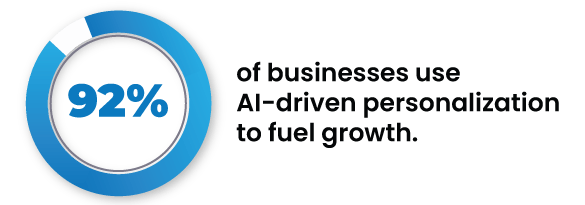
The Future of Website Personalization
The future of website personalization is set to transform digital experiences, making them smarter, more predictive, and deeply user-centric. AI and machine learning will increasingly power hyper-personalization, analyzing real-time behavior and predicting individual preferences to deliver tailored content, product recommendations, and dynamic experiences. Personal website templates will make it easier for brand narratives to quickly deploy customized designs, while personalization sites will extend seamless personalization across omnichannel touchpoints, ensuring consistent engagement wherever customers interact with a brand.
Ethical and privacy-conscious approaches will become essential, as first- and zero-party data replace third-party tracking, allowing brands to personalize transparently while giving users control over their data. Personalization will also thrive post-purchase, with personalized rewards and loyalty programs strengthening engagement and building long-term relationships. Meanwhile, AI copilots will redefine interactions, curating journeys in real time and providing intuitive, conversational guidance across platforms. Community building will further amplify personalization, giving brands direct insight into customer preferences, fostering meaningful connections, and reducing reliance on paid media. Ultimately, personalization will no longer be optional—it will be the baseline expectation.
Websites that anticipate behavior, respect privacy, and deliver relevant experiences across all channels will not only meet user expectations but also create lasting brand loyalty, driving growth in increasingly competitive markets. The key lies in combining intelligent technology, ethical data practices, and human-centric design to craft experiences that feel personal, predictive, and purposeful at every click, scroll, and interaction.
Conclusion
In the coming years, website personalization will be a critical driver of user experience and business growth. As B2B buyers expect tailored interactions, personalization helps brands deliver relevant content, product suggestions, and solutions that align with each customer’s needs. By leveraging AI, predictive analytics, and real-time data, companies can create seamless, omnichannel experiences that feel natural and intuitive. Ethical data use and privacy-respectful practices will be essential for building trust. When done right, personalization not only improves engagement and conversions but also strengthens customer relationships, turning routine interactions into meaningful connections that foster loyalty and long-term success.

